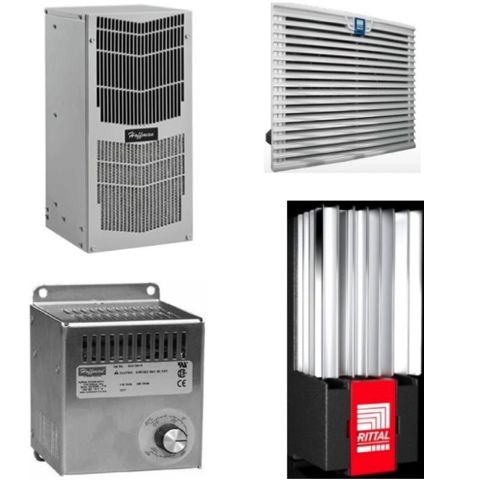Enclosure Thermal Management

Maintaining the right temperature inside electrical enclosures is essential for protecting sensitive components and ensuring long-term equipment performance. At RSP Supply, we offer a complete range of enclosure thermal management solutions; including fans, air conditioners, heat exchangers, thermoelectric coolers, vortex coolers, and heaters. Our selection includes trusted products from Stahlin, Rittal, and nVent Hoffman, leaders in the design of durable and efficient enclosure cooling and heating systems. Whether you need industrial air conditioners for high-heat environments, filter fans for airflow, or heaters to prevent condensation, RSP Supply provides the right solution for your application.
We understand that enclosure thermal management isn’t just about cooling - it’s about protecting uptime, safety, and performance. From precision temperature control with nVent Hoffman air conditioners to heat exchangers from Rittal and rugged, weather-resistant Stahlin accessories, our products deliver consistent results you can count on.
FAQ's
1: Why is enclosure thermal management important?
Proper temperature control prevents overheating, condensation, and component failure, ensuring safe, continuous operation of electrical and electronic equipment.
2: What are the main types of enclosure cooling systems?
RSP Supply offers industrial air conditioners, fans, heat exchangers, vortex coolers, and thermoelectric coolers; each designed to match specific heat loads and environmental conditions.
3: Which brands make the best enclosure cooling products?
We carry Stahlin, Rittal, and nVent Hoffman, all known for high-performance enclosure systems built for industrial durability, energy efficiency, and long service life.
4: Do I need heaters in my enclosures?
Yes, if your enclosures are exposed to cold or humid environments. Heaters prevent condensation and maintain steady internal temperatures to protect sensitive electrical components.
5: Can RSP Supply help me choose the right cooling system?
Absolutely. Our knowledgeable team can help calculate heat loads, compare cooling technologies, and recommend the best Stahlin, Rittal, or nVent Hoffman thermal management solution for your specific application.
Why Buy Enclosure Thermal Management Products from RSP Supply
Top Industry Brands: We stock high-quality thermal management solutions from Stahlin, Rittal, and nVent Hoffman, trusted worldwide for performance and reliability.
Complete Product Range: From simple filter fans to advanced air conditioning and heating systems, we have solutions for every enclosure type and environment.
Industrial Expertise: Our team understands real-world challenges and can help you design or retrofit enclosures for optimal performance.
Fast Shipping & Availability: We keep core products in stock for quick delivery - minimizing downtime and keeping your projects moving.
Reliable Support: RSP Supply is more than a distributor - we’re your partner in protecting equipment, improving efficiency, and reducing maintenance costs.

